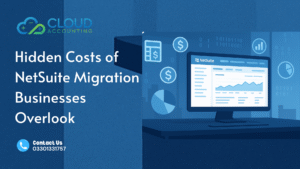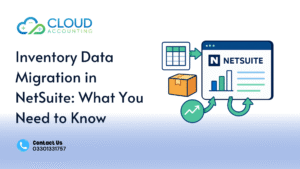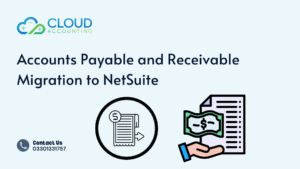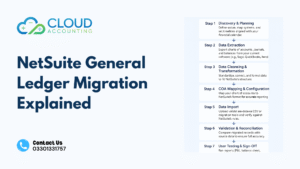Most businesses plan their NetSuite migration with a clear idea of license fees and consultant rates. Yet, once the process begins, many are surprised to find unexpected expenses creeping in ones that weren’t included in the original quote or timeline. These hidden NetSuite migration costs can easily stretch your budget and delay your project if not anticipated early.
NetSuite migrations are complex because they involve far more than data transfer. Each step from cleaning old records to configuring integrations — adds time, resources, and sometimes third-party tools. Understanding these unseen expenses is essential to plan a realistic budget and avoid disruption to your accounting or reporting systems.
At Cloud Accounting, we’ve helped hundreds of companies transition to NetSuite successfully. One of the biggest lessons we’ve seen? Businesses that prepare for hidden costs ahead of time complete their migration faster, with fewer post-launch issues and a clearer return on investment.
Why Understanding NetSuite Migration Costs Matters
Budgeting for a NetSuite migration is often more than a numbers exercise — it’s a strategic step toward sustainable financial control. When companies underestimate hidden NetSuite migration costs, it’s usually because they only consider the initial migration quote. But those figures rarely include the work required to clean, test, or validate your data once it’s inside NetSuite.
Missing these expenses can lead to:
- Delays in financial reporting due to inaccurate or incomplete data
- Cash flow issues caused by unexpected consulting or rework costs
- Reduced system performance from unplanned integrations or manual fixes
- Team frustration from lack of training or support after go-live
That’s why a transparent migration plan — one that breaks down every potential cost — is vital. When you know what to expect, you can make informed decisions, compare provider quotes more accurately, and maintain your budget with confidence.
The Top Hidden NetSuite Migration Costs You Should Know
When businesses migrate to NetSuite, most assume that the quoted migration fee covers everything. Unfortunately, that’s rarely the case. The real financial impact lies in the extras — those tasks that fall outside the standard scope but are essential for a clean, accurate migration. Below are the most common hidden NetSuite migration costs that often go unnoticed until it’s too late.
1. Data Cleanup and Preparation Fees
One of the biggest hidden NetSuite migration costs comes long before the actual migration begins — in the data cleanup stage. Many businesses underestimate how much time and effort it takes to prepare their legacy data for import.
Old accounting systems often contain duplicate records, incomplete customer profiles, and outdated transactions. Before moving to NetSuite, these need to be reviewed, corrected, and formatted to match NetSuite’s structure.
Typical tasks that add cost include:
- Removing duplicates and inactive customers
- Mapping account codes to new NetSuite categories
- Correcting transaction dates and tax codes
- Validating historical balances
Data cleanup fees can range from a few hundred to several thousand dollars, depending on the size and condition of your dataset. Investing in this stage is crucial — migrating bad data can lead to errors that cost even more to fix later.
2. Integration with Third-Party Systems
Most businesses don’t use NetSuite in isolation. You may rely on CRMs, payroll systems, ecommerce platforms, or inventory tools that all need to connect with your ERP. Integrating these systems is one of the most commonly overlooked NetSuite migration expenses.
While basic NetSuite migration pricing might include a simple data import, connecting third-party tools like Salesforce, Shopify, or ADP requires custom API work or middleware. Each connection adds developer time, testing, and maintenance costs.
To avoid surprise charges:
- List every system that must connect to NetSuite
- Confirm integration costs before signing off your migration plan
- Ask whether ongoing API updates are included or billed separately
3. Customization and User Configuration
NetSuite’s flexibility is one of its biggest strengths — but customization isn’t free. If your business processes require tailored workflows, approval chains, or dashboard layouts, you’ll likely face additional configuration fees.
Every adjustment to fit your operations — from custom fields in invoices to department-based reporting — adds project hours. Over time, these hours add up and inflate your overall migration cost.
A good practice is to prioritize only the most critical customizations at launch, then schedule the rest for later phases once you’re live and stable.
4. Post-Migration Support and Training
Many companies assume their NetSuite migration partner provides free support after go-live. In reality, post-launch support is one of the most frequent hidden costs businesses encounter.
After migration, teams often need training to navigate new dashboards, workflows, and reporting tools. Some users also face technical issues when reconciling old and new records. These support and training sessions are usually billed hourly or packaged separately.
At Cloud Accounting, we recommend confirming whether post-migration support is included in your plan — and for how long. Investing in early user training reduces rework and ensures your team gets full value from the platform.
5. Downtime and Productivity Loss
Even with perfect planning, migrating to NetSuite often means a short period of reduced productivity. Your finance team may be unable to access live systems while data is imported or validated.
This downtime cost is rarely reflected in quotes but can have a measurable business impact — especially if you process invoices, payroll, or reports daily. Planning your migration during off-peak periods or over a weekend can minimize disruption and protect your bottom line.
Each of these factors can add thousands to your total NetSuite migration budget. However, with proper planning and expert oversight, most of these hidden expenses can be anticipated — or even avoided entirely.
How to Accurately Budget for a NetSuite Migration
Creating a realistic budget for your NetSuite migration is about more than listing costs — it’s about understanding what each stage involves. The difference between a smooth project and a costly one often comes down to preparation and visibility.
At Cloud Accounting, we’ve seen that businesses who take time to assess their data, integrations, and team needs upfront experience fewer delays and spend less overall. Here’s how you can build a practical migration budget that accounts for every stage — including the hidden NetSuite migration costs most companies overlook.
1. Start with a Full Cost Breakdown
Before requesting quotes, outline each phase of your migration: assessment, data preparation, import, testing, and post-launch support. This breakdown helps you identify where extra costs might appear, such as manual cleanup, reformatting, or system integration.
Create a list that includes:
- Data extraction and validation
- Data cleanup and mapping
- Integration setup and testing
- Customization or configuration work
- User training and support
Having these categories defined ensures vendors provide more transparent pricing — and makes it easier to compare proposals accurately.
2. Request Transparent Pricing from Your Migration Partner
Many businesses get caught off guard because migration quotes often cover only “standard data migration.” That usually means basic accounts, contacts, and transactions — but not complex data, automations, or advanced features.
When reviewing proposals, ask your migration partner:
- What’s included in the base fee?
- What tasks might trigger additional charges?
- How is post-migration support billed?
At Cloud Accounting, we believe in upfront pricing with no hidden fees. Every migration project includes a detailed scope document showing exactly what’s covered, so there are no surprises later.
3. Budget for Testing and Validation
Testing might not sound expensive, but skipping it can lead to costly errors. Once your data is inside NetSuite, your accounting team must confirm that balances, invoices, and reports match your legacy system.
If discrepancies appear, fixing them can require manual reconciliation — another source of hidden NetSuite migration costs. Build time and budget into your plan for:
- Trial migrations or test runs
- Balance sheet and profit-and-loss verification
- User acceptance testing (UAT) before go-live
Testing protects your data integrity and helps ensure you launch with accurate, trusted financial information.
4. Factor in Post-Migration Support
The transition doesn’t end when your data appears in NetSuite. Your team may need guidance for tasks like running reports, managing permissions, or adjusting workflows.
Post-migration support often costs extra, especially if you rely on consultants for troubleshooting or training. Instead of viewing it as an add-on, treat it as an investment in productivity. When your staff understands how to use NetSuite effectively, they’re less likely to make costly mistakes or require emergency support later.
5. Learn from Real-World Examples
One mid-sized retailer we worked with expected their NetSuite migration to take four weeks. But after reviewing their historical data, we discovered years of inconsistent transaction coding that would have caused serious balance errors.
By identifying this early, we helped them clean their records before migration — saving an estimated $6,000 in post-launch fixes and preventing a month-long reporting delay.
This example shows why anticipating hidden NetSuite migration costs isn’t just about saving money — it’s about protecting your business continuity.
Expert Tips to Avoid Unnecessary Migration Expenses
Avoiding hidden NetSuite migration costs isn’t about cutting corners — it’s about making informed decisions before the project begins. With the right preparation, clear communication, and professional guidance, you can complete your migration on time and within budget. Here are proven strategies from our Cloud Accounting migration experts.
1. Choose Certified Migration Specialists
Working with certified migration professionals can save you thousands. Certified partners understand NetSuite’s data structure, accounting logic, and API behavior — meaning fewer errors and less rework.
At Cloud Accounting, every project is handled by experienced migration specialists who plan, test, and validate each phase to ensure accuracy. We know what typically triggers hidden costs and address those risks before they impact your timeline or budget.
2. Audit and Clean Your Data Early
Data cleanup is one of the most common and costly oversights. Start by auditing your legacy data before any technical work begins. Remove duplicates, fix account codes, and ensure your chart of accounts aligns with NetSuite’s format.
Doing this early reduces migration time and prevents problems that might otherwise require manual corrections later — one of the easiest ways to avoid unexpected NetSuite migration costs.
3. Review Every Integration in Advance
Integrations can make or break your migration. List every platform your business depends on — from ecommerce and payroll to CRM systems — and verify how each will connect to NetSuite.
Many hidden NetSuite migration costs come from overlooked integrations that require custom connectors or manual data syncing. By mapping your integrations early, you can request accurate quotes and plan for any additional development work.
4. Run a Test Migration Before Going Live
A test migration, sometimes called a trial run, is one of the best ways to predict the true scope of your project. It lets you see how your data appears in NetSuite and whether any formatting or mapping issues exist.
If discrepancies are found, you can correct them before the final migration, preventing expensive post-launch adjustments. Cloud Accounting includes test runs as part of every migration plan, giving you full visibility into your data accuracy before go-live.
5. Plan for User Training and Ongoing Support
Even the best migration can fail if users don’t understand the new system. Allocating budget for hands-on NetSuite training helps teams adapt quickly and reduces costly downtime.
Our team at Cloud Accounting offers tailored post-migration support sessions covering reporting, dashboards, and accounting workflows — ensuring your staff feel confident from day one.
6. Keep Communication Open Throughout the Project
Surprise costs often stem from miscommunication between the business and migration team. Regular project check-ins, clear documentation, and shared progress reports keep everyone aligned.
This proactive communication helps prevent scope creep — and with it, unnecessary expenses that can derail your migration budget.
In short, preventing hidden NetSuite migration costs comes down to preparation and partnership. When you plan ahead, work with certified professionals, and budget for testing and support, you’ll gain a clearer path to success — and long-term value from your NetSuite investment.
Plan Ahead with Cloud Accounting
Every successful NetSuite migration starts with clear visibility — not just into your data, but into the costs that surround it. Hidden NetSuite migration costs can derail even the most carefully planned projects, but with the right partner, you can anticipate and control them before they affect your business.
At Cloud Accounting, we help companies migrate to NetSuite with precision, transparency, and peace of mind. Our specialists go beyond standard data transfer — we analyze your existing setup, prepare your data, handle integrations, and validate every record post-migration. The result is a cleaner, faster, and more predictable transition.
Here’s what you can expect when partnering with us:
- Upfront pricing: No vague estimates or hidden fees.
- Certified migration experts: Experienced professionals who’ve managed complex NetSuite projects across multiple industries.
- End-to-end support: From initial assessment to go-live and beyond.
- Error-free validation: Every number double-checked before your team starts using the new system.
If you’re planning your move to NetSuite this year, now is the best time to review your migration costs and uncover any potential surprises.
Get a Free Migration Cost Review
Or book a discovery call to learn how Cloud Accounting can help your business migrate smarter, faster, and with fewer hidden expenses.
Frequently Asked Questions About Hidden NetSuite Migration Costs
1. What are the most common hidden NetSuite migration costs?
The most common hidden NetSuite migration costs include data cleanup, system integration, user training, and post-launch support. Many companies also overlook testing and downtime expenses during the transition period.
2. How can I reduce data migration expenses?
Start by cleaning and reviewing your data before migration. Remove duplicates, verify balances, and align account codes with NetSuite’s format. Early preparation reduces migration time and minimizes rework costs later.
3. Is post-migration support included in NetSuite pricing?
In most cases, no. Post-migration support is typically billed separately by your migration provider. At Cloud Accounting, we offer dedicated go-live assistance and user training to help your team adapt quickly.
4. Why does integration add to the total NetSuite migration cost?
Integrations with third-party systems — like Shopify, Salesforce, or payroll software — require custom connectors or API work. These technical setups are often excluded from standard migration quotes, leading to extra costs if not planned in advance.
5. How does Cloud Accounting ensure accurate and transparent pricing?
We provide a detailed migration scope document that outlines all included and potential costs before any project begins. This transparency allows clients to plan confidently and avoid unexpected charges later in the process.
Final Thoughts
\Hidden NetSuite migration costs can turn a well-planned upgrade into a financial strain. But with expert guidance and upfront budgeting, you can make the transition smooth and predictable.
Contact Cloud Accounting today to book your free cost review and uncover potential savings before your migration begins.








